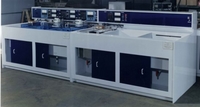|
Home >> Articles >> Metal Finishing - Plating - Anodizing
Titanium Anodizing - Surgical Implants&Aerospace
Staff
Surgical Implants - Titanium Anodizing
 One of the more recent uses of metal finishing in the past 30 years involves titanium anodizing of surgical implants used in reconstructive surgery of bone and skeletal injuries. The use of titanium for surgical implants has many advantages over other metals. Titanium is a very light yet a very hard metal. It machines well to precise tolerances and is extremely resistant to corrosion. Many times a broken bone needs to be fastened to other bone mass to allow time for the bones to nit together. Titanium fasteners have proven to fill the bill in many cases. One of the more recent uses of metal finishing in the past 30 years involves titanium anodizing of surgical implants used in reconstructive surgery of bone and skeletal injuries. The use of titanium for surgical implants has many advantages over other metals. Titanium is a very light yet a very hard metal. It machines well to precise tolerances and is extremely resistant to corrosion. Many times a broken bone needs to be fastened to other bone mass to allow time for the bones to nit together. Titanium fasteners have proven to fill the bill in many cases.
Because of a unique characteristic of titanium, anodizing of the metal is very practical and very easy to accomplish. Unlike aluminum the anodizing process for titanium does not involve the use of hazardous chemicals in most applications. In addition titanium can be colored in many hues for purposes of identification. For example if a surgeon decides to select a fastener with a specific thread dimension and diameter the fasteners can be color coded for in-field identification without resorting to direct measurement. The color coding can be done by the fastener supplier using titanium anodizing, a whole range of colors from purple to gold can be created. Color coding also helps in maintaining inventory control by hospital employees not familiar with fastener nomenclature or dimensional identification.
Titanium Anodizing - A Rainbow of Colors
The anodizing of titanium involves a series of steps. These steps include surface preparation including cleaning and in some cases polishing where brilliant surfaces are desirable. As with all metal finishing the surface characteristics of the base metal will determine the final outcome of the finish. After cleaning the titanium fastener is immersed in one of a variety of solutions which allow the transfer of direct current between an anode and cathode. This transfer of current imparts an oxide film across the surface of the fastener.
 This film has the unique characteristic of refracting light in the color spectrum much in the same way a thin film of oil refracts light in a pool of water. You literally get the colors of the rainbow. This oxide film can be varied in thickness by increasing the DC voltage. This gives the metal finisher the ability to "dial in" the colors he wants. The beauty of this process is that unlike aluminum the use of color dyes and sealers is not necessary. This film has the unique characteristic of refracting light in the color spectrum much in the same way a thin film of oil refracts light in a pool of water. You literally get the colors of the rainbow. This oxide film can be varied in thickness by increasing the DC voltage. This gives the metal finisher the ability to "dial in" the colors he wants. The beauty of this process is that unlike aluminum the use of color dyes and sealers is not necessary.
Titanium Anodizing is Affordable
In the opinion of this author, the manufacturer of titanium surgical implants should seriously consider bringing this process in house. The cost for outsourcing titanium anodizing, time delays, small lots processing, ease of process control and the absence of hazardous chemicals are just a few of the reasons bringing this process in-house makes sense.
 Titanium anodizing modular systems can cost from about $40,000 up to $85,000 complete, depending upon the configuration and production requirements, and leasing is available. For further information about anodizing titanium, putting in your own titanium anodizing system, or titanium anodizing equipment, please click below. Titanium anodizing modular systems can cost from about $40,000 up to $85,000 complete, depending upon the configuration and production requirements, and leasing is available. For further information about anodizing titanium, putting in your own titanium anodizing system, or titanium anodizing equipment, please click below.
|
|
© IPEC Global, Inc. All Rights Reserved.
|

 One of the more recent uses of metal finishing in the past 30 years involves titanium anodizing of surgical implants used in reconstructive surgery of bone and skeletal injuries. The use of titanium for surgical implants has many advantages over other metals. Titanium is a very light yet a very hard metal. It machines well to precise tolerances and is extremely resistant to corrosion. Many times a broken bone needs to be fastened to other bone mass to allow time for the bones to nit together. Titanium fasteners have proven to fill the bill in many cases.
One of the more recent uses of metal finishing in the past 30 years involves titanium anodizing of surgical implants used in reconstructive surgery of bone and skeletal injuries. The use of titanium for surgical implants has many advantages over other metals. Titanium is a very light yet a very hard metal. It machines well to precise tolerances and is extremely resistant to corrosion. Many times a broken bone needs to be fastened to other bone mass to allow time for the bones to nit together. Titanium fasteners have proven to fill the bill in many cases.  This film has the unique characteristic of refracting light in the color spectrum much in the same way a thin film of oil refracts light in a pool of water. You literally get the colors of the rainbow. This oxide film can be varied in thickness by increasing the DC voltage. This gives the metal finisher the ability to "dial in" the colors he wants. The beauty of this process is that unlike aluminum the use of color dyes and sealers is not necessary.
This film has the unique characteristic of refracting light in the color spectrum much in the same way a thin film of oil refracts light in a pool of water. You literally get the colors of the rainbow. This oxide film can be varied in thickness by increasing the DC voltage. This gives the metal finisher the ability to "dial in" the colors he wants. The beauty of this process is that unlike aluminum the use of color dyes and sealers is not necessary.  Titanium anodizing modular systems can cost from about $40,000 up to $85,000 complete, depending upon the configuration and production requirements, and leasing is available. For further information about anodizing titanium, putting in your own titanium anodizing system, or titanium anodizing equipment, please click below.
Titanium anodizing modular systems can cost from about $40,000 up to $85,000 complete, depending upon the configuration and production requirements, and leasing is available. For further information about anodizing titanium, putting in your own titanium anodizing system, or titanium anodizing equipment, please click below.